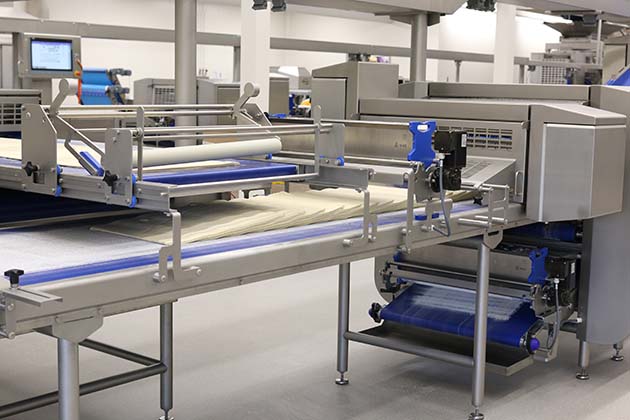
From viennoiserie to Danish pastry, and any number of hybrid, new creations, laminated dough is the path to the sought-after airy, light layers. Gentle dough stretching and folding is a must, however, there is by no means a one-size-fits-all approach to the process. Tried and tested laminating methods and line setups can accommodate flexibility and consistency in results.
Precision and consistency are required to turn blocks of dough into thin, delicate sheets. The big challenge lies in the correct distribution of the dough reduction steps while avoiding any unwanted tension in the dough. Inconsistencies in the reduction steps will significantly impact the structure of the final product.
SoftProcessing technology: FRITSCH
The answer to challenges in laminating dough perfected by FRITSCH is its SoftProcessing technology, which helps avoid any unnecessary tension and compression. It is featured in the company’s laminators to produce uniform dough sheets. It should be noted this range of machines was renamed to cluster them according to end-product groups and performance spectrum: Laminator 900, 1100, 1300 and 1500 are part of the industrial range, and the LAMINATOR 700 is specialized in mid-range production. The numbers indicate the table width of the LAMINATOR.The operating principles of the FRITSCH SoftProcessing technology are as follows: the pre-portioner of the dough band former (the FRITSCH TBP) works with two rollers that constantly fill the TBP with dough so that the amount of dough contained always remains the same.
“The dough is therefore constantly spread under the same pressure. The TBP forms a thick dough band using a five-roller dough sheet former,” the specialist explains. In the next processing step, the FRITSCH satellite head and the cross roller ensure that the dough band is clearly defined and calibrated to the desired dough thickness. Fats (e.g., butter or margarine) are then applied with a fat pump, to ensure that it is evenly discharged onto the dough band and that a clearly defined ratio of dough to fat is maintained. “Our industrial LAMINATOR can optionally be equipped with a water separator, which is placed just before the nozzle of the fat pump,” FRITSCH adds, so that it can be drained off when butter is used, and therefore not reach the dough band and impact its quality.
Product and process flexibility
The industrial LAMINATOR can use various folding units with layering units being the primary choice for high-volume production. They ensure precise laminating as it places layers accurately on top of each other to form dough blocks. The table under them is height-adjustable, to minimize the drop height of the dough. The layering unit can process a wide variety of types of laminated dough, such as croissant, yeast, puff pastry and brioche dough. It can achieve various amounts of layers and foldings, respectively, including odd numbers of layers. The fold width and number of layers can also be adjusted automatically.
Numerous parameters can be set and components adjusted on the LAMINATOR to produce an optimal dough band for each product. The newly-developed FRITSCH Operating System (FOS) is key to having the equipment adapt and adjust to process variations. “With the new FOS, the system is controlled according to performance. With the new control panel, numerous basic programs and corresponding performance parameters are available for different products, where only a few parameters, such as the rolling gap and number of layers, need to be readjusted to achieve the desired result,” the company details. The FOS uses predefined programs, which simplifies the use of existing recipes and the introduction of new ones, in which case only a set of defaults have to be set such as the line output, the number of folds and the roller gap, and not all data points from scratch. “This significantly reduces the time needed for setting up a new product. The software checks whether the desired change in output is feasible. The drives coordinate with each other in terms of their performance and, if necessary, regulate themselves to that of the smallest drive,” FRITSCH explains the steps.
”The FRITSCH SPIs are a dashboard that grants our customers a live insight into their production, enabling complete process transparency.“
FRITSCH specialists
In addition, components on the line can be started automatically when needed, for efficiency. For example, flour dusters or cross rollers will only be switched on when they are currently being used in the production process. “This is a standard feature of our industrial laminating lines (LAMINATOR 900, 1100, 1300, 1500),” FRITSCH underlines.
The LAMINATOR can also be equipped with a cooling chamber for additional benefits, including:
+ An even and faster cooling process, to control the yeast activity
+ Uniformity for downstream processing steps
+ Consistent quality
Coming soon
FRITSCH is working on further technology updates and is preparing to introduce a new innovation this year, the company shared with us: the FRITSCH Smart Production Insights (SPIs). “The FRITSCH SPIs are a dashboard that grants our customers a live insight into their production, enabling complete process transparency. With the continuous capture of data and visualization of key performance indicators in real-time, it will be possible to achieve further improvements still in overall equipment effectiveness,” the company anticipates. The data provided by the SPIs can pinpoint the exact cause of disruptions or malfunctions, and take actions accordingly, to prevent such unplanned downtimes.
Cameras added to the line’s set-offs are another new feature, added to make it easy to observe hard-to-see places during production, such as the cooling tunnel, for example.
The FRITSCH LAMINATOR can process a wide range of doughs. “Depending on the desired end product, our LAMINATOR can easily process up to 8 tons of dough per hour in industrial use,” the company highlights.

The article is part of an extended feature, which was originally published in [BBI 1 – 2022]. Read the full article in the magazine:


